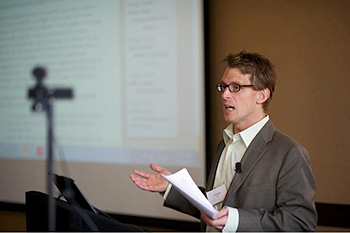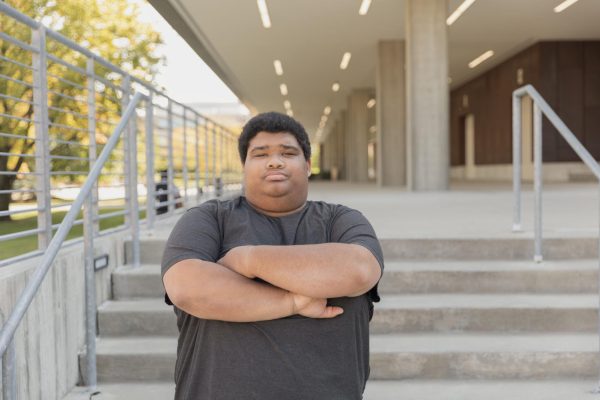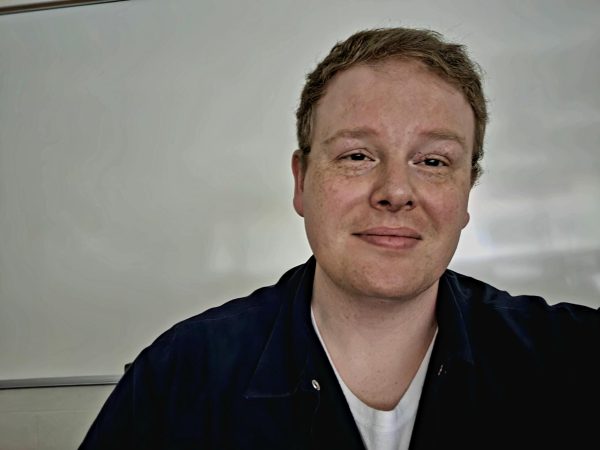Letter to the editor: Does the BOT practice what it preaches?

Photo courtesy of Oakland University
Oakland University Professor of English Jeffrey Insko.
Like many of my colleagues, I was deeply disappointed this week by the Oakland Board of Trustees’ dismissal of the AAUP’s request to appoint a faculty liaison to the Board. That decision constitutes yet another in a long line of recent actions by University leaders that indicate a disturbing disregard for faculty concerns.
What makes this action especially troubling is the fact that the damage inflicted by the University’s harsh—and bad faith—positions in last fall’s contract negotiations is far from repaired. Dedicated professionals, we faculty have gone back to doing the work of teaching and research that we care about most, but our morale remains low, distrust and suspicion linger, discontent and demoralization still run deep. So while things may seem quiet now, the reality is that relations between the faculty and administration are as strained as they were in September, which is to say, they are as bad as I’ve experienced in the nearly twenty years I’ve been here.
To address and hopefully begin to redress this troubling state of affairs, the union leadership proposed a modest step toward healing, a simple measure designed to initiate some much-needed dialogue between faculty and University decision makers that could lead, at the very least, to some mutual understanding. In response to this request, the Board of Trustees doubled down on the status quo.
In his letter to the union, Board President Bobby Schostak provides no explanation as to why the Board isn’t interested in engaging honestly and openly with the faculty. Instead, he merely asserts, rather evasively, that the Board “remains committed to best practices and transparent communications along with shared governance.”
But what exactly are the “best practices” to which the Board, in Mr. Schostak’s view, remains committed? After all, arrangements such as the one proposed by the union aren’t unique. Michigan State has a faculty liaison to its Board. Central Michigan’s Board has a faculty liaison committee. Nationally, according to one study, 13.3 percent of public institutions have boards with voting faculty members while another ten percent include non-voting faculty members on their boards.
Indeed, the Cornell University researchers who conducted that study begin with the observation that “discussions of ‘best practices’ for governing boards consistently cite improved relationships with the faculty as one of the characteristics of highly effective boards.” These organizations promote precisely the kinds of practices that Oakland’s Board seeks to evade. For example, the Association of Governing Boards of Universities and Colleges (AGB)—of which Oakland University is a member!– outlines a series of best practices for shared governance that are designed to maximize interaction and open dialogue between faculty members and Board members. These include measures as simple as encouraging casual social interaction between faculty and Board members at University as well as more formal measures, such as giving “legitimacy to faculty leaders by inviting them to the table at crucial junctures in a decision-making process, which “may include invitations to board committee meetings, full board meetings, and board retreats” and “meet[ing] annually with faculty leaders, aside from normal board meetings and faculty meeting times. Doing so allows for a full and open exchange of ideas.” The AGB’s guidelines, which I encourage everyone to read, include a number of similar practices designed to build trust and respect. Yet in my experience, such practices are utterly foreign to the way Oakland’s Board conducts itself.
Even organizations whose philosophies of higher education differ substantially from mine recommend similar measures. The influential consulting firm McKinsey & Company recommends “includ[ing] faculty and students as board meeting observers and nonvoting trustees” or even “formally includ[ing] both groups as voting trustees” as appropriate ways to “effectively incorporate the voices of faculty.” Similarly, the conservative American council of Trustees and Alumni (ACTA) in its “Blueprint for Higher Education Trustees” insists that “trustees need to listen carefully to faculty concerns and become knowledgeable so that they can make highly informed decisions. When their decisions depart from faculty wishes, they must be able to articulate why that is appropriate.” Does Oakland’s Board adhere to these practices?
Similarly, the Board claims to be committed to transparent communication but when given the opportunity to actually demonstrate that commitment, the board declines. Instead, Mr. Schostak merely says that faculty “will always be given an opportunity to address the Board of Trustees.” Yet the only real mechanism for such address is the public comment period of the Trustees’ public meetings. But that system, in which commenters are limited to two minutes and the Board is under no obligation to respond, is hardly designed to foster conversation, open dialogue, reciprocity, or trust—the basic building blocks of transparent communication.
Or take another example. Recently, in a genuine effort to establish a more productive mode of exchange between the faculty and the Board, my colleague, collaborator, and department chair Rob Anderson contacted the Board’s newest member, David Kramer, to welcome him to his new position. Rob reached out in a gesture of goodwill, asking for nothing more than a friendly chat over lunch as a step toward opening a channel of communication and beginning to build a bridge between the faculty and the Board. Perhaps the invitation got lost in an email shuffle– I hope that’s the case–but for whatever reason, Rob never received a reply. Another opportunity for transparent communication lost.
I don’t expect that the faculty and the Board or the faculty and the administration are always going to see eye to eye. Disagreement, as I try to teach my students, is okay, even healthy. But disagreement isn’t healthy if one party refuses even to engage and instead builds a wall between itself and others, shields itself from direct encounters, and is accountable to no one. If not a faculty liaison to the Board, what measures and initiatives, specifically, is the Board taking to enact their stated commitment to transparent communication? What exactly, if not those that I have cited, are the best practices guiding their conduct? And most importantly, aren’t we supposed to be in this together? Aren’t we all committed to the University’s mission? Wouldn’t it be better to fulfill that mission collaboratively rather than antagonistically? The faculty is ready and willing. Why isn’t the Board?
Jeffrey Insko
Professor of English






anon • Jan 29, 2022 at 3:00 PM
Reasoning with these people implies believing in a non-zero probability of their change. Well, satan’s repentance seems more likely. The only way to deal with them is to purge our school of this clique of malignant narcissistic mediocrities. Unfortunately, the university professoriate’s reaction to egregious abuse did not warrant even a no-confidence vote. All responses I’ve seen thus far are in the realm of enabling. Enabling narcissists is a well-paved path to perdition.
Anon • Jan 31, 2022 at 1:14 PM
I fully agree. The reason the board has not opened up communication with the faculty is because they do not want or care to. Narcissists do not negotiate, they rule with an iron fist. This situation will only get worse.
Robert Anderson • Jan 28, 2022 at 3:49 PM
Great points. Makes you wonder why the Board opposes this. What harm can it do?